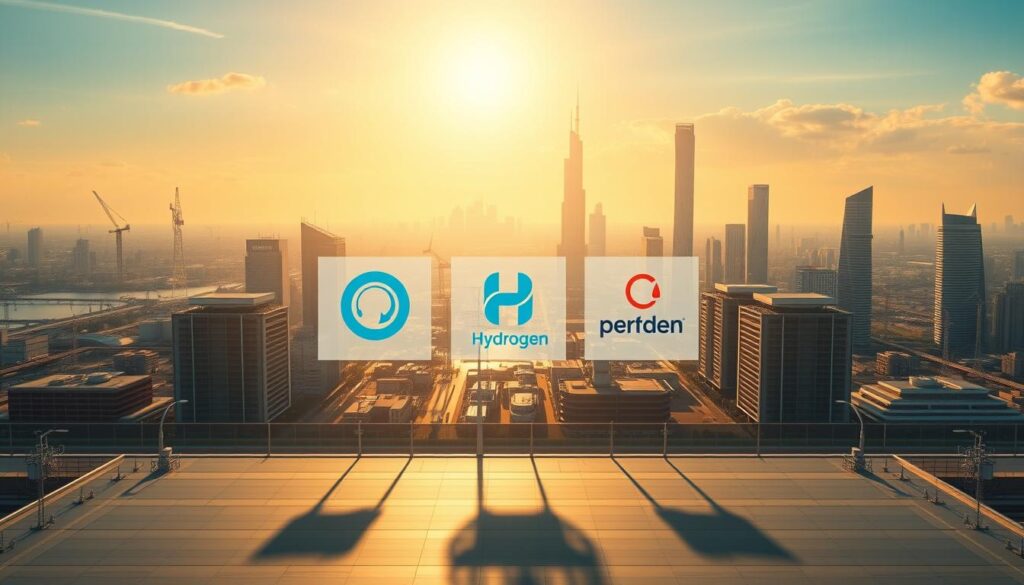The next few years could reshape how the world powers industries, vehicles, and homes. By 2025, breakthroughs in clean energy solutions are expected to accelerate, with green hydrogen investment leading the charge. This innovative fuel source, produced using renewables, promises to cut emissions while meeting growing demand.
Experts predict an $11 trillion market potential for this sector. The U.S. Department of Energy aims to slash production costs to $1 per kilogram, making it more accessible. For investors, this creates a rare chance to support sustainable progress while tapping into a booming market.
Key Takeaways
- 2025 is a turning point for renewable energy advancements.
- Green hydrogen could revolutionize multiple industries.
- The sector offers massive financial potential.
- Government targets aim to lower production costs.
- Early investment may yield long-term benefits.
Why Green Hydrogen Is the Future of Clean Energy
The shift toward sustainable fuel solutions is gaining momentum worldwide. Unlike traditional fossil fuels, this alternative releases only water vapor when used. That makes it a powerhouse for cutting carbon emissions.

Today, most hydrogen comes from natural gas, costing just $1.50 per kg. But the cleaner version, made with renewables, sits at $5. The U.S. Department of Energy aims to slash that to $1 by 2030.
Environmental Edge Over Fossil Fuels
Burning coal or oil spews harmful gases. Hydrogen? Just H2O. It’s a clear win for air quality and climate goals.
| Factor | Traditional Fuels | Hydrogen |
|---|---|---|
| Byproduct | CO2, pollutants | Water vapor |
| Cost (per kg) | $1.50 (natural gas) | $5 (renewable) |
Blue vs. Green: What’s the Difference?
Blue hydrogen uses natural gas but captures the emissions. Green skips fossils entirely, relying on wind or solar. The latter is the gold standard for clean energy.
Right now, 95% of production isn’t green. Scaling up renewables is key to flipping that ratio.
Where Hydrogen Shines
From trucks to factories, it’s versatile. It fuels heavy transport and cuts steel-making pollution. But storage and transport infrastructure need work.
The potential is huge. With smarter tech and policies, this could be the backbone of a cleaner future.
Hydrogen Green Energy: 5 Companies Dominating 2025
The race to revolutionize clean fuel is heating up, with major players stepping into the spotlight. These innovators are blending cutting-edge technology with bold investments to redefine how industries operate. Here’s who’s leading the charge.

Air Products: Pioneering Blue Solutions
Air Products is betting big on blue hydrogen, with a $4.5B facility in Louisiana. The project will store 5M tons of CO₂ yearly, making it a game-changer for heavy industries. Though their Massena project was scrapped, their LNG expertise keeps them ahead.
BP’s Green Gambit
BP aims to produce 500k–700k tons of clean fuel annually by 2030. Partnering with Iberdrola, they’re building Germany’s largest electrolyzer. This shift from oil to renewables marks a pivotal moment for the energy giant.
Plug Power’s Fuel Cell Empire
With 69,000 deployed fuel cells and 250+ North American stations, Plug Power is building an ecosystem. Their Amazon warrant deal and «Project Quantum Leap» highlight ambitions to dominate logistics and beyond.
Bloom Energy’s Efficiency Edge
Bloom’s solid oxide electrolyzers boast 15–45% higher efficiency than rivals. This tech is critical for decarbonizing steel and chemicals—industries hungry for sustainable alternatives.
Linde’s Carbon-Capture Mastery
Linde’s $1.8B Texas ammonia plant with ExxonMobil showcases their carbon capture prowess. Their patents in compression and storage make them a backbone for global hydrogen projects.
The Surging Global Green Hydrogen Market
Investors are eyeing a market set to multiply 80-fold in under a decade, fueled by government backing. Analysts project a 55.7% annual growth rate, catapulting the sector from $716 million to $60 billion by 2032. This isn’t just hype—it’s a transformation backed by hard data.

Projected Growth: From $716M to $60B by 2032
Asia-Pacific leads the charge, with a 65% growth rate driven by China’s 400km pipeline by Sinopec and India’s National Green Hydrogen Mission. The Adani Group’s $70 billion renewable push further cements the region’s dominance.
Europe counters with its Repower Policy, targeting 10 million tons of annual production. The U.S. leans on tax credits, aiming to slash costs through its Clean Hydrogen Roadmap.
Government Policies Fueling Adoption
India’s mission offers $2 billion in incentives, while the EU mandates 50% clean fuel for heavy transport by 2030. The U.S. sweetens deals with a $3/kg tax credit, making production economics irresistible.
- India: Blending mandates and export ambitions.
- EU: Infrastructure mandates and carbon pricing.
- U.S.: Production credits and R&D grants.
These global strategies aren’t just competing—they’re creating a rising tide for the entire sector.
How Green Hydrogen Stacks Up Against Fossil Fuels
Clean alternatives are challenging fossil fuels like never before. With lower carbon emissions and growing infrastructure, the scales are tipping. But how do they really compare?
Fuel cells outshine lithium-ion batteries in heavy-duty uses. They’re 2–3 times more energy-dense than gasoline, making them ideal for trucks and ships. Yet, storing and moving this fuel remains tricky.
Existing natural gas pipelines could be repurposed, cutting costs. Europe’s testing this now, blending up to 20% hydrogen. But pure hydrogen needs upgrades to prevent leaks.
| Metric | Fossil Fuels | Hydrogen |
|---|---|---|
| Energy Density (MJ/kg) | 45 (gasoline) | 120–142 |
| Grid Stability | Limited storage | Stores excess renewables |
| Maritime Use | High emissions | Zero CO2 |
Steel mills show the biggest promise. Switching to hydrogen could slash their carbon emissions by 90%. Sweden’s HYBRIT project already proves it works.
LNG has a head start in transport, with global terminals. Hydrogen needs similar hubs. Blue hydrogen bridges the gap, using natural gas with carbon capture until green scales up.
For grids, hydrogen stores surplus wind or solar energy. When demand peaks, it powers turbines without fossil backups. That’s a game-changer for reliability.
The transition won’t happen overnight. But with smarter production and policies, cleaner fuels could soon dominate.
Investment Risks and Rewards in Hydrogen Stocks
Navigating the world of hydrogen stocks requires balancing potential rewards with calculated risks. While the sector promises growth, understanding the pitfalls ensures smarter decisions. Here’s what you need to know.
ETFs like HDRO offer exposure with a 0.5% expense ratio—lower than many sector funds. But individual companies vary widely. Plug Power, for example, expects improved cash flow by 2024, while Cummins is gaining electrolyzer market share.
Volatility in Emerging Players
Pre-revenue firms often swing wildly on news. Policy shifts or delayed projects can crater valuations overnight. Diversified energy giants may offer steadier returns.
| Factor | Pure-Play Stocks | Diversified Firms |
|---|---|---|
| Risk Level | High (e.g., Plug Power) | Moderate (e.g., Linde) |
| Policy Dependence | Critical (tax credits) | Buffered by other segments |
| Production Scale | Growing (7M kg/day for Linde) | Established infrastructure |
Policy: A Double-Edged Sword
Tax incentives today could vanish tomorrow. Amazon’s warrant deal with Plug Power—tying investment to performance—shows how firms hedge bets.
Yet, breakthroughs in technology, like cheaper electrolyzers, could offset risks. The key? Research and patience.
Beyond 2025: What’s Next for Hydrogen Energy?
The horizon of fuel innovation stretches far beyond current expectations. By 2050, the Hydrogen Council predicts this resource could meet 18% of global energy demand. That’s not just incremental growth—it’s a revolution.
Projects like Siemens-UNIPER’s green methanol plants are already testing scalable solutions. Meanwhile, Toyota and CaetanoBus are rolling out light-vehicle prototypes, proving versatility across sectors.
Data centers might soon run on fuel cells, slashing their carbon footprints. Ammonia, easier to transport than pure hydrogen, could become a global energy carrier. Pilot programs in residential heating are also gaining traction.
The U.S. DOE’s Hydrogen Shot aims to cut costs by 80% within a decade. Fusion energy, though nascent, might eventually pair with hydrogen production for near-limitless clean power.
Challenges remain, like building infrastructure for storage and transport. But with each breakthrough, the future of this fuel looks brighter. From labs to factories, the pieces are falling into place.
FAQ
What makes green hydrogen different from traditional fuel sources?
Unlike fossil fuels, it’s produced using renewable power, emitting zero carbon when used. This makes it a key player in reducing emissions across industries.
Which sectors benefit most from hydrogen fuel cells?
Heavy transport, manufacturing, and energy storage see the biggest gains. These areas need high-energy solutions without the pollution of conventional fuels.
How do companies like Air Products and Linde contribute to hydrogen technology?
Air Products focuses on large-scale production, while Linde integrates carbon capture. Both are expanding infrastructure to meet global demand for clean alternatives.
Why is government support crucial for the hydrogen market?
Policies and subsidies lower costs for producers and buyers. Countries investing in infrastructure help accelerate adoption, making projects more viable.
Conclusion
The push for clean energy is reshaping industries, and hydrogen stands at the forefront. Leaders like Air Products and Plug Power are driving innovation, backed by a projected 55.7% annual market growth.
While investment opportunities are promising, watch for risks like oversupply or shifting policies. Diversifying your portfolio with both pure-play and established firms can balance potential rewards.
Stay updated on global developments, from tax incentives to tech breakthroughs. The future of renewable energy hinges on smart choices today.



